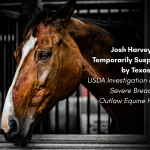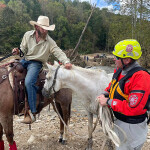The new year is approaching, and that brings plenty of new events horse owners want to achieve. For some horse owners, those milestones can include purchasing a new horse, foaling and breeding, or achieving training milestones. But for some horse owners, the new year could even bring a new horse property.
Buying your first horse property or upgrading your facility is an exciting accomplishment but it does come with one major management step: establishing and maintaining horse pastures. Well maintained pastures not only add value and eye appeal to your horse property, but can provide excellent turnout conditions for your horses. Pasture turnout can provide enrichment, exercise opportunities, and be an excellent source of forages for a horse’s diet. But, if not established and managed correctly, pastures can become barren wastelands and cost a fortune to reestablish.
There are multiple considerations horse owners need to consider when establishing a new horse pasture from the beginning. These considerations include:
- Timing
- Soil sampling
- Fertilizer
- Seed bed preparation
- Planing seeds
- Weed Control
- Grazing management
Timing
August through November is the best time to establish cool-season pasture grasses, such as Timothy, Kentucky bluegrass, Orchardgrass, tall fescue and annual ryegrass. The temperatures are cooler, there is usually more moisture and also less weed pressure. All of these factors will allow seedlings time to develop a root system prior to winter. If fall planting is not possible, spring is the second best time to plant.
Warm season grasses, such as Bermudagrass, Indiangrass, Johnsongrass and Switchgrass, should have been planted in late spring to early summer since the soil must be at least 65℉. Seeds planted in the spring will have more moisture for germination but are at risk for more weed pressure.
Soil Sampling
Before any seeding or anything pasture related, the most important step for pasture establishment is soil sampling. Soil sampling allows owners to know the nutrient needs of their soil and pH levels; this should be done every three years. Collecting soil samples is relatively easy for horse owners to do.
To start, horse owners should contact their county’s Extension office for soil sample collection boxes and the field sample submission sheet. Next, owners should collect about 5-10 subsamples from each of their pastures in the shape of an “M” and samples should be taken at a depth of 3 inches with either a soil probe or a spade shovel. Owners should do their best to make sure their “M” shaped soil sample pattern covers their entire pasture. Remove the surface residue, mix the subsamples thoroughly in a clean plastic bucket but be sure to keep each pasture sample separated! Fill the soil sample boxes with the subsamples, fill out the field sample submission sheet, and mail out the samples and sheet to the following address (for owners that live in Tennessee): Soil, Plant and Pest Center, 5201 Marchant Drive, Nashville, TN 37211.
For horse owners in other states, please contact your county’s Extension office for your land-grant university’s soil testing lab. Results will be mailed and emailed within 3-5 business days. The best advice to speed up results delivery is to mail soil samples early in the week (Monday or Tuesday) to receive results by the end of the week.
Fertilizer
Young, growing plants need extra help to get started growing so most horse owners will apply fertilizer. When establishing a grass pasture, owners should apply 90 lbs of Nitrogen/acre, 30 lbs of P2O5/acre and 40 lbs of K2O/acre just prior to or during seeding. Additionally, fertilizer should be applied right before rain (about ½ inch) is predicted as sunlight will neutralize pellets if left out.
After a pasture has been established, 90 lbs of Nitrogen/acre should be spread annually while P2O5 and K2O applications will depend on soil analysis. Annual fertilizer application should be split in half, applying half of the recommended amount in the late spring (April or early May) and half in the early summer (June). There is no present length of time to remove horses from pasture to avoid ingestion of fertilizer but owners should make sure pellets are not visible.
Applying fertilizer incorrectly can be detrimental to a new pasture, thus having a soil testing result can save horse owners time and money in fertilizer. The ideal soil pH level is 5.5-7.0 for most grass pasture species. If your soil test states your soil is more acidic (4.0 or lower), plants will not take up any fertilizer. To increase the soil pH, lime-based compound should be applied to neutralize the soil.
Seed Bed Preparation
Good soil to seed contact is critical to maintain moisture near the seeds since moisture is needed for germination. For seedbed preparation, the best type depends on the type of equipment owners have available and whether the pasture is being established or already exists. For new pastures, conventional tillage is the best method while no-till drill is the best method.
Conventional tillage needs to be used when a uniform seedbed is needed. The soil should be firm, but smooth and fine, which will allow moisture to germinate the seed. The seeds should also be drilled at a depth of ¼ to ½ inch.
No-till uses herbicides to destroy existing vegetation then seeds directly into the ground. Most no-till seed beds are prepared in late summer and planted in the fall.
Large farming equipment for horse owners can be a stretch to obtain if said equipment is not already on hand but there are options. Owners should contact local farms, Ag CO-OPs, local equipment rental businesses or soil and water conservation districts for equipment availability.
Planting Seeds
Selecting the appropriate seeds is important for new pasture establishment. Owners need to match forage species to the soil, sit, and type of operation (grazing grass or hay, animal species and class). In addition, owners need to decide if their pastures will consist of cool season grasses, warm season grasses, a mixture or legume forage. Cool season grasses grow best between 60°F to 80℉, peaking in the spring and fall season. Warm season grasses grow best between 80℉ to 95℉, peaking in the late spring until the first frost. Legumes, such as alfalfa, can provide nitrogen to grasses and increase pasture quality but make sure the legume is compatible with grass species to reduce species competition.
When to plant seeds is also an important factor. Cool season grasses should be planted 4-6 weeks before the first frost to allow time for adequate growth while warm season grasses should be planted in late spring to early summer once the soil reaches 65℉ or higher. As for how much seeds to spread, new pastures should receive 25 pounds of seed per acre.
Weed Control
Weed management is vital to ensure pasture forage establishment since new seedlings are vulnerable to weed competition. Mowing should be used as the main weed control strategy since new seedlings are more prone to herbicide injury. If herbicides are used, make sure to select products labeled for horse pasture use, read and follow instructions, especially any grazing restrictions, and do not apply herbicides in areas with standing water. If weeds are dense, consider spot applying. If horse owners want to take an extra precaution with herbicide application, horses can be turned back out on pasture 7 days following herbicide application.
Grazing Management
In time, new seedlings will emerge but horse owners should not let their horses graze before the root system has developed since new seedlings can be pulled out by grazing horses. Once seeds have been planted, allow the new seedlings to grow 4-6 inches. To stimulate root development, mow new forages 3-4 inches, allow the forage to re-grow 4-6 inches then mow again. This process should be repeated 2-3 times in the fall and spring. Once the new seedlings have reached 8-12 inches, new pastures can be lightly grazed by horses until the pasture is grazed down to about 4-6 inches.
Remember not to overstock your pastures with too many horses. The rule of thumb is every horse needs about 2 acres of pasture so be sure to implement rotational grazing management strategies.
For any further questions about new pasture establishment and management, do not hesitate to contact your county’s Extension office. UT-TSU Shelby County Extension can be reached at 901-752-1207 during normal business hours Monday through Friday 8am-4:30pm CST.










